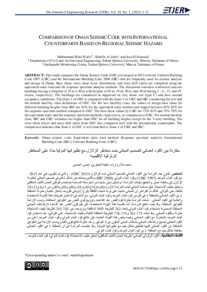Document
Comparison of seismic and wind actions on medium to high-rise buildings in Muscat, Oman.
Identifier
DOI:10.53540/tjer.vol.20iss2pp149-160
Source
Journal of Engineering Research, v. 20, no. 2, p. 149-160.
Contributors
Country
Oman.
City
Muscat
Publisher
College of Engineering, Sultan Qaboos University.
Gregorian
2023-04-29
Language
English
English abstract
his study is a comparison of wind
and seismic loads on medium and high-rise
buildings in Muscat, Oman. It uses the proposed
Omani Seismic Code and Eurocode EN1991 for
seismic and wind calculations, respectively. Muscat
falls under Zone-1 in the Omani seismic code and
experience basic wind speed of 30 m/sec. The
research investigates buildings with varying aspect
ratios (1:1 and 1:2), heights (11, 15, and 19
stories), and structural layouts (frame only, core
shear wall, and corner shear wall), using ETABS for
structural analysis. The findings reveal that seismic
actions are generally more significant than wind
actions for buildings in Muscat. In frame-only
structures, wind-induced base shear ranges from
16%-33% for 1:1 aspect ratio and 21%-43% in the
x-direction and 10%-20% in the y-direction for 1:2
aspect ratio, when compared to seismic actions.
This difference decreases with increasing building
height. Incorporating shear walls notably reduces
the maximum lateral displacement across all
scenarios, with core-located walls being most
effective, leading to a 49% reduction in lateral
displacement. Shear walls also substantially
mitigate first-story column shear forces and
bending moments. The study concludes that
seismic actions are more critical than wind actions
in Muscat for simple moment-resisting frame
systems. Additionally, using shear walls in these
buildings is highly beneficial for controlling lateral
displacements and reducing member forces.
ISSN
Online: 1726-6742
Print: 1726-6009
Arabic abstract
ChatGPT
الملخص المستخرج من الصورة كما ورد في المقال:
الملخص:
إن الهدف من هذه الدراسة هو مقارنة الأحمال الناجمة عن قوى الزلازل والرياح على المباني متوسطة وعالية الارتفاع في مسقط بسلطنة عمان. تم استخدام الكود العماني للزلازل والكود الأوروبي لحساب تأثير الزلازل والرياح. تقع مسقط ضمن المنطقة الزلزالية 1 وفقًا للكود العماني، وتبلغ سرعة الرياح الأساسية 30 م/ث. تم تحليل مبانٍ ذات نسب أبعاد مختلفة (1:1 و1:2) وارتفاعات (11، 15، و19 طابقًا) وتصاميم هيكلية متنوعة (إطار فقط، جدار قص مركزي، وجدار قص عند الزوايا) باستخدام برنامج ETABS للنمذجة والتحليل الهيكلي.
أظهرت النتائج أن أحمال الزلازل أكثر أهمية من الأحمال الناتجة عن الرياح في هياكل المباني ذات الإطار فقط، حيث تراوحت نسبة قوى القص الناتجة عن الرياح بين 16% - 33% لنسبة أبعاد 1:1، وبين 21% - 43% في الاتجاه x و10% - 20% في الاتجاه y لنسبة أبعاد 1:2. كما بينت الدراسة أن هذا الفرق يتناقص مع زيادة ارتفاع المبنى.
أدى استخدام جدران القص إلى تقليل الإزاحة الجانبية القصوى بنسبة 49%، حيث كانت الجدران الموجودة في المركز أكثر فعالية في تخفيف الإزاحة الجانبية في جميع أشكال المباني تحت تأثير الزلازل. بالإضافة إلى ذلك، فإن تكوين الجدران عند المركز أو الزوايا يساعد في تقليل قوى القص في الأعمدة وعزوم الانحناء في الطابق الأول، مما يؤدي إلى تحسين استجابة المبنى لقوى الزلازل.
خلصت الدراسة إلى أن تأثيرات الزلازل تعتبر أكثر أهمية من تأثيرات الرياح في مسقط، خاصة لأنظمة الإطارات المقاومة للعزوم. كما أن استخدام جدران القص في هذه المباني يعد حلاً فعالًا للغاية في التحكم في الإزاحات الجانبية وتقليل القوى الداخلية في العناصر الإنشائية.
الملخص المستخرج من الصورة كما ورد في المقال:
الملخص:
إن الهدف من هذه الدراسة هو مقارنة الأحمال الناجمة عن قوى الزلازل والرياح على المباني متوسطة وعالية الارتفاع في مسقط بسلطنة عمان. تم استخدام الكود العماني للزلازل والكود الأوروبي لحساب تأثير الزلازل والرياح. تقع مسقط ضمن المنطقة الزلزالية 1 وفقًا للكود العماني، وتبلغ سرعة الرياح الأساسية 30 م/ث. تم تحليل مبانٍ ذات نسب أبعاد مختلفة (1:1 و1:2) وارتفاعات (11، 15، و19 طابقًا) وتصاميم هيكلية متنوعة (إطار فقط، جدار قص مركزي، وجدار قص عند الزوايا) باستخدام برنامج ETABS للنمذجة والتحليل الهيكلي.
أظهرت النتائج أن أحمال الزلازل أكثر أهمية من الأحمال الناتجة عن الرياح في هياكل المباني ذات الإطار فقط، حيث تراوحت نسبة قوى القص الناتجة عن الرياح بين 16% - 33% لنسبة أبعاد 1:1، وبين 21% - 43% في الاتجاه x و10% - 20% في الاتجاه y لنسبة أبعاد 1:2. كما بينت الدراسة أن هذا الفرق يتناقص مع زيادة ارتفاع المبنى.
أدى استخدام جدران القص إلى تقليل الإزاحة الجانبية القصوى بنسبة 49%، حيث كانت الجدران الموجودة في المركز أكثر فعالية في تخفيف الإزاحة الجانبية في جميع أشكال المباني تحت تأثير الزلازل. بالإضافة إلى ذلك، فإن تكوين الجدران عند المركز أو الزوايا يساعد في تقليل قوى القص في الأعمدة وعزوم الانحناء في الطابق الأول، مما يؤدي إلى تحسين استجابة المبنى لقوى الزلازل.
خلصت الدراسة إلى أن تأثيرات الزلازل تعتبر أكثر أهمية من تأثيرات الرياح في مسقط، خاصة لأنظمة الإطارات المقاومة للعزوم. كما أن استخدام جدران القص في هذه المباني يعد حلاً فعالًا للغاية في التحكم في الإزاحات الجانبية وتقليل القوى الداخلية في العناصر الإنشائية.
Category
Journal articles

